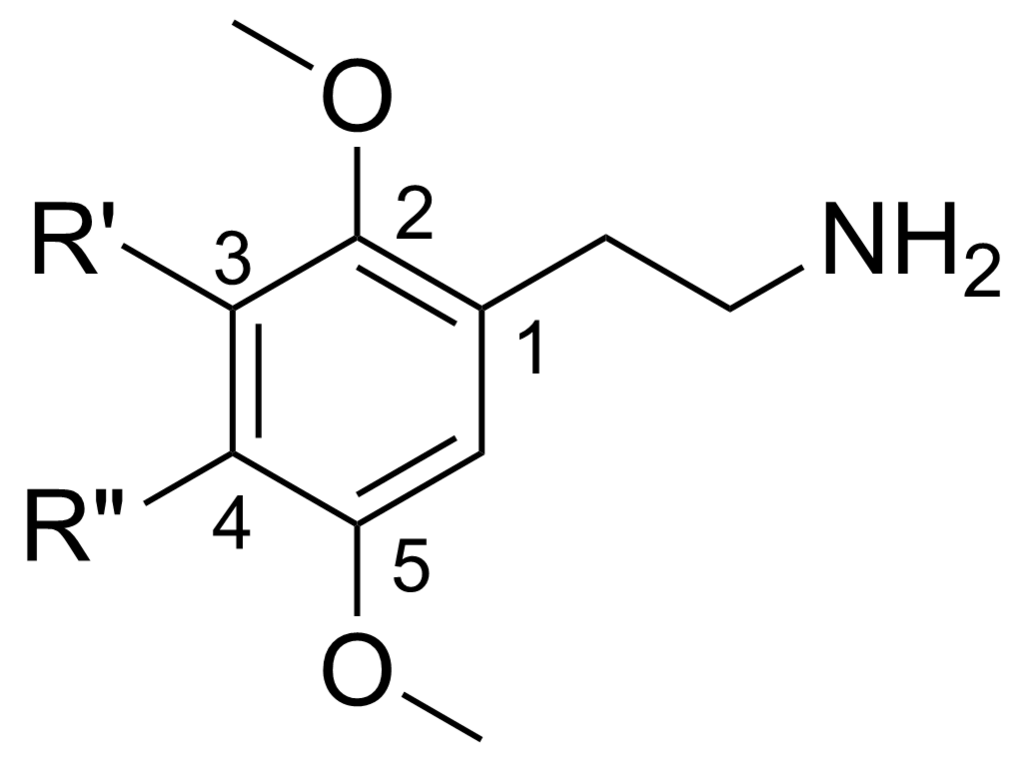Summary
2C (2C-x) is a collective term used to refer to a group of psychedelic phenethylamines characterized by the presence of methoxy groups on the 2 and 5 positions of a benzene ring. Additionally, most members of this group feature lipophilic substituents at the 4 position, which often results in more potent compounds, have enhanced metabolic stability, and offer longer-lasting effects. Alexander Shulgin originally synthesized the majority of the 2C compounds known today during the 1970s and 1980s. Shulgin documented these compounds in his book PiHKAL (Phenethylamines I Have Known And Loved) and is credited with coining the term “2C,” which stands for the two carbon atoms situated between the benzene ring and the amino group.

Legality
In Canada, as of October 12, 2016, the 2C-x family of substituted phenethylamines has been classified as a controlled substance under Schedule III.
FAQ
1. What are 2C psychedelics?
- 2C psychedelics are a group of phenethylamine compounds known for their hallucinogenic and psychedelic effects. They share a common structural feature of methoxy groups on the 2 and 5 positions of a benzene ring.
2. How are 2C psychedelics classified?
- 2C psychedelics are typically classified as substituted phenethylamines. The specific compound may carry a designation like “2C-x,” with the “x” indicating variations in the specific substituents on the molecule.
3. Who is credited with discovering 2C psychedelics?
- Alexander Shulgin is credited with synthesizing and researching many 2C compounds in the 1970s and 1980s. His work is documented in the book “PiHKAL” (Phenethylamines I Have Known And Loved).
4. What are the effects of 2C psychedelics?
- The effects of 2C psychedelics can vary depending on the specific compound, but they generally include altered perception, hallucinations, and changes in thought processes. Effects may also include sensory enhancement and emotional experiences.
5. Are 2C psychedelics legal?
- The legal status of 2C psychedelics varies by country and specific compound. In some places, they are classified as controlled substances, while in others, they may not be specifically scheduled.
6. Can 2C psychedelics be used for therapeutic purposes?
- Research into the therapeutic potential of 2C psychedelics is limited. Most research on therapeutic psychedelics has focused on substances like psilocybin and MDMA.
7. Are there risks associated with using 2C psychedelics?
- Like other hallucinogens, 2C psychedelics can carry risks, including psychological distress, hallucinogen-persisting perception disorder (HPPD), and adverse reactions. Responsible use and proper precautions are advised.
8. What is the legal status of 2C psychedelics in Canada?
- As of October 12, 2016, the 2C-x family of substituted phenethylamines is classified as a controlled substance (Schedule III) in Canada.
9. Where can I find more information about 2C psychedelics?
- To learn more about 2C psychedelics, refer to scientific literature and reliable sources and consult with healthcare professionals. Staying informed and making informed decisions is essential when considering the use of these substances.
References
- Alexander Shulgin, Tania Manning, and Paul F. Daley authored “The Shulgin Index. Volume 1. Psychedelic Phenethylamines and Related Compounds,” published by Transform Press in 2011 with ISBN 978-0-9630096-3-0.
- In “Phenethylamine Von der Struktur zur Funktion,” authors Daniel Trachsel, David Lehmann, and Christoph Enzensperger explore the subject, with relevant content spanning from pages 762 to 810. This work was published by Nachtschatten Verlag AG in 2013, featuring ISBN 978-3-03788-700-4.
- Alexander Shulgin and Ann Shulgin’s “PiHKAL: A Chemical Love Story” was published in September 1991 by Transform Press, Berkeley, California. The book is available under ISBN 0-9630096-0-5 and is cataloged under OCLC 25627628.
- The study “Creation and application of psychoactive designer drugs data library using liquid chromatography with a photodiode array spectrophotometry detector and gas chromatography–mass spectrometry” was authored by M. Takahashi, M. Nagashima, J. Suzuki, T. Seto, I. Yasuda, and T. Yoshida. It was published in the journal “Talanta” on February 15, 2009.
- Leth-Petersen S, Petersen IN, Jensen AA, Bundgaard C, Bæk M, Kehler J, and Kristensen JL contributed to the study “5-HT2A/5-HT2C receptor pharmacology and intrinsic clearance of N-benzylphenethylamines modified at the primary site of metabolism,” published in “ACS Chem. Neurosci.” on November 16, 2016.
- The article titled “Shulgin’s Sulfur Symphony – Part I” was featured on the website “countyourculture” on January 15, 2011. The content is archived on the site.
- In the “Helvetica Chimica Acta,” Daniel Trachsel’s work “Synthesis of novel (phenylalkyl)amines for the investigation of structure-activity relationships. Part 2. 4-Thio-substituted [2-(2,5-dimethoxyphenyl)ethyl]amines (=2,5-dimethoxybenzeneethanamines)” was published in 2003 (Vol. 86, No. 7, pp. 2610–2619).
- The book “Phenethylamine: Von der Struktur zur Funktion” authored by Daniel Trachsel, David Lehmann, and Christoph Enzensperger was published by Nachtschatten Verlag AG and is available with ISBN 978-3-03788-700-4.
- Patent WO 2022/006186 titled “Phenalkylamines and Methods of Treating Mood Disorders” lists AC Kruegel as the patent holder.
- “Regulations Amending the Food and Drug Regulations (Part J — 2C-phenethylamines)” was published in the Canada Gazette on April 15, 2016.
